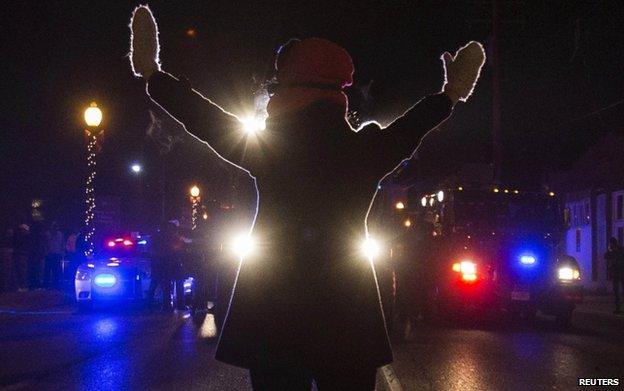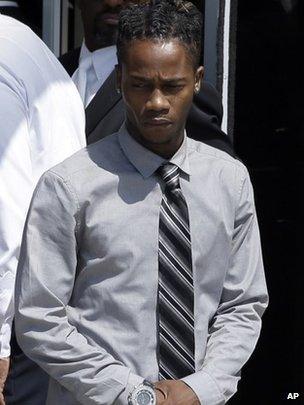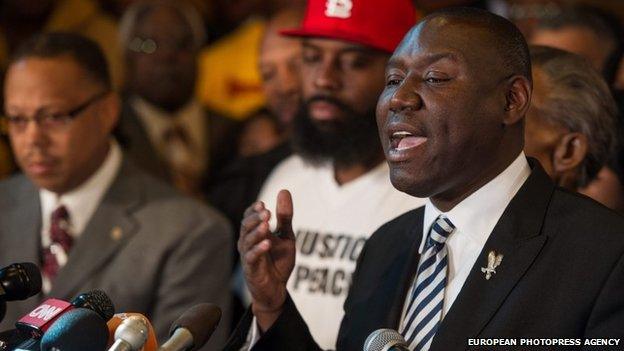Ferguson unrest: From shooting to nationwide protests
- Published

The city of Ferguson, Missouri, has been a flashpoint for nationwide protests since the killing of an unarmed black teenager by a white police officer last year.
Protests in Ferguson followed Michael Brown's death and a grand jury declining to charge the officer with murder. A justice department investigation has also found widespread alleged racial bias in the police force.
Several days after the justice department report was released in March, two police officers were shot and injured. Later in August, a man was critically injured in a gunfire exchange with police during a rally marking the one-year anniversary of Brown's death.
Why are they protesting?
Demonstrators are calling for more action to be taken following the release of a federal report, external that alleged overwhelming racial bias in the town's policing.
Ferguson's police force has faced severe criticism since the shooting of Michael Brown in August 2014, leading to the sacking or resignation of several officials, including police chief Thomas Jackson.
Initially, the demonstrations focused on Ferguson but in November they spread to other US cities after a jury decided not to charge police officer Darren Wilson over the killing.
Mr Wilson is white. Mr Brown was black. The demonstrators see the case in terms of racism and police brutality.
Following the release of the justice department report, the US authorities vowed to reform the police force, possibly by dismantling it.

What exactly happened in Ferguson?
The exact details of what happened that day remain disputed by police, eyewitnesses and family members.
What is known for certain is that around midday on 9 August 2014, Mr Wilson was driving a police car and encountered Mr Brown and a friend walking down a street.
Minutes later 18-year-old Mr Brown was dead, suffering at least seven gunshot wounds, according to county prosecutor Bob McCulloch. His body lay in the street for four hours before it was removed.
Mr Wilson fired a total of 12 bullets, though investigators were unclear exactly how many of the 12 struck Mr Brown. One injury may have been a re-entry wound.


What does Officer Wilson say happened?
Officer Wilson says he confronted Mr Brown and Mr Johnson at around midday on 9 August. The officer, who was in his vehicle, says he told the men to move to the pavement because they were walking down the middle of the road, holding up traffic.
The men ignored his request. When the officer spoke to the men again, he realised they were suspects in a robbery reported nearby.
He radioed for more officers and reversed his vehicle to block the men's way. Officer Wilson says he tried to open the door of his vehicle but Mr Brown slammed it shut. The officer says Mr Brown struck him in the face when he tried to use the door to push him back.
Officer Darren Wilson, who shot and killed Michael Brown: "I know I did my job right"
Officer Wilson says he drew his gun and threatened to shoot Mr Brown, fearing another punch to the face. Mr Brown is said to have challenged him, reaching through the window to grab the gun. The officer says a scuffle took place in which the weapon was fired twice but remained with him.
Mr Brown and Mr Johnson ran off. Officer Wilson left the vehicle and ran after them. Officer Wilson says he asked Mr Brown to get on the ground. But, he says, Mr Brown turned around and charged at him, with a hand reaching under his shirt in the waistband of his trousers.
Officer Wilson says he fired several shots at Mr Brown, who was gaining on him.

What do other witnesses say happened?

Dorian Johnson was with Michael Brown at the time. After the initial exchange, Mr Johnson says the policeman reversed his vehicle, reached out and grabbed Mr Brown by the neck. The men engaged in a "tug of war", he says, holding on to each other's shirt and arms.
Mr Johnson says he heard Mr Wilson threaten to shoot. He did not see Mr Brown punch the officer and he did not believe Mr Brown had grabbed the officer's gun.
He says Mr Brown stopped when the officer ran after him, raising his hands in a gesture of surrender. Mr Johnson says Mr Brown was shot in this position - rather than while charging at the officer.
There are other witnesses who support what Officer Wilson says happened, but they haven't spoken to the media.

What did the jury decide?
In November, St Louis County grand jury and the US justice department failed to find enough evidence to bring charges against Officer Wilson.
The panel of jurors was composed of 12 citizens picked at random. Six were white men, three were white women, there was one black man and two black women.
They had heard testimony from scores of witnesses, as well as from forensic and medical experts. The evidence from witnesses was often contradictory.
Some of it had supported Officer Wilson's version of events. Other witness statements had appeared to support the account of Dorian Johnson, Mr Brown's friend who was with him when he died.
Unusually, St Louis County prosecutor Robert McCulloch did not recommend any charges against Officer Wilson to the jury. This caused anger in Ferguson as critics said it showed an unwillingness to prosecute.

Why has there been criticism of the legal process?

Crump questioned the fairness of the jury process
"This process is broken," said the Brown family's lawyer, Benjamin Crump.
Justice had not been served, he said, because Darren Wilson had not been cross-examined when he gave evidence to the grand jury.
Mr Crump also identified what he said were inconsistencies in the officer's evidence and condemned the "symbiotic relationship" between prosecutor Mr McCulloch and the local police force.
Critics of Mr McCulloch have also expressed concern about his impartiality. His father, a police officer, was shot dead by a black man in the 1960s.
What did the justice department investigation find?
The US justice department opened two investigations after Mr Brown's death. The first did not recommend any federal civil rights charges against Mr Wilson, given the high legal standard needed to so.
But a second investigation into the Ferguson police force and court system at large found widespread racial bias in the city's institutions including -
Police were quick to escalate force and when they did, African-Americans accounted for 90% of officers' use of force
Explicit racial bias in communications between police and court
The court's practices impose unnecessary harm, overwhelmingly on African Americans, including arrest warrants are issued if fines are not paid, instead on the basis of public safety
Many officers appear to see some residents, especially those who live in Ferguson's predominantly African American areas, less as constituents to be protected than as potential offenders and sources of revenue for the city
Racial bias in Ferguson
93%
of people arrested are African Americans, whereas only:
67%
of Ferguson population is black
-
96% of people arrested for outstanding municipal warrants are African American
-
95% of "Manner of walking in roadway" charges were against black people
-
90% of documented force was against African Americans
-
30% of searches of white suspects resulted in a contraband finding - compared with 24% of black suspects
Mr Holder himself called the report "searing" and suggested that while the available evidence did not support the argument Mr Wilson acted illegally, it was not hard to understand why protests had erupted in the town.
"Amid a highly toxic environment, defined by mistrust and resentment, stoked by years of bad feelings, and spurred by illegal and misguided practices - it is not difficult to imagine how a single tragic incident set off the city of Ferguson like a powder keg," Mr Holder said.
What happens now?

St Louis County Police Chief Jon Belmar said it was a "miracle" officers had not been shot before
Police Chief Tom Jackson was the sixth person to be fired or resign from Ferguson's city government after the publication of the report.
Protesters took to the streets hours after his resignation to call for more heads to roll.
But as a relatively low-key demonstration was breaking up after Mr Jackson's resignation, two St Louis County police officers were shot and injured by gunfire.
On 9 August, a year after Michael Brown was killed, a man was shot and injured during a gun battle with police at a protest rally to mark the one year anniversary.
The justice department will look for changes in Ferguson police force and court system, and have reserved their right to enforce needed changes through a settlement.
St Louis police chief Jon Belmar has demurred over whether his police force could effectively take over the city's police department.